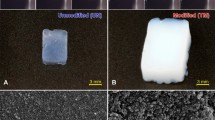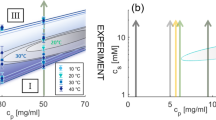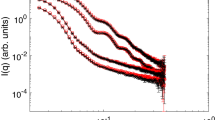Abstract
The mechanism of the heat-induced gelation of ovalbumin (OVA) under acidic conditions and the effect of amphiphilic peptide additives on gelation were investigated using dynamic light scattering (DLS) and small-angle neutron scattering (SANS). This combination of techniques provides structural details spanning a wide range of length scales, from micrometer (DLS) to nanometer (SANS). The molecular morphology and structure probed by SANS suggest that the heat-induced gelation of OVA solution forms a phase-separated structure. The addition of an amphiphilic peptide to the system drastically changed the aggregated structure by promoting the formation of OVA clusters. Furthermore, heating of the solution of OVA and the peptide resulted in effective distribution of the peptide in the matrix of the heat-induced OVA gels and endowed the gel with increased strength. This simplistic approach to increase the gel strength can be applied to any protein/peptide gel system to impart the gel system with specific physical properties required by their intended application.
This is a preview of subscription content, access via your institution
Access options
Subscribe to this journal
Receive 12 print issues and online access
$259.00 per year
only $21.58 per issue
Buy this article
- Purchase on Springer Link
- Instant access to full article PDF
Prices may be subject to local taxes which are calculated during checkout







Similar content being viewed by others
References
Remold-O’Donnell E. The ovalbumin family of serpin proteins. FEBS Lett. 1993;315:105–8.
Mine Y. Recent advances in the understanding of egg white protein functionality. Trends Food Sci Technol. 1995;6:225–32.
McReynolds L, O’Malley BW, Nisbet AD, Fothergill JE, Givol D, Fields S, et al. Sequence of chicken ovalbumin mRNA. Nature. 1978;273:723–8.
Stein PE, Leslie AGW, Finch JT, Turnell WG, McLaughlin PJ, Carrell RW. Crystal structure of ovalbumin as a model for the reactive centre of serpins. Nature. 1990;347:99–102.
Stein PE, Leslie AGW, Finch JT, Carrell RW. Crystal structure of uncleaved ovalbumin at 1·95 Å resolution. J Mol Biol. 1991;221:941–59.
Doi E, Kitabatake N. Structure of glycinin and ovalbumin gels. Food Hydrocoll. 1989;3:327–37.
Dobson CM. Protein folding and misfolding. Nature. 2003;426:884–90.
Selkoe DJ. Folding proteins in fatal ways. Nature. 2003;426:900–4.
Rousseau F, Schymkowitz J, Serrano L. Protein aggregation and amyloidosis: confusion of the kinds? Curr Opin Struct Biol. 2006;16:118–26.
Su Y-YT, Jirgensons B. Further studies on detergent-induced conformational transitions in proteins: circular dichroism of ovalbumin, bacterial α-amylase, papain, and β-lactoglobulin at various pH values. Arch Biochem Biophys. 1977;181:137–46.
Kato A, Takagi T. Formation of intermolecular.beta.-sheet structure during heat denaturation of ovalbumin. J Agric Food Chem. 1988;36:1156–9.
Nakamura R, Ishimaru M. Changes in the shape and surface hydrophobicity of ovalbumin during its transformation to S-Ovalbumin. Agric Biol Chem. 1981;45:2775–80.
Arntfield SD, Murray ED, Ismond MAH, Bernatsky AM. Role of the thermal denaturation-aggregation relationship in determining the rheological properties of heat induced networks for ovalbumin and vicilin. J Food Sci. 1989;54:1624–31.
Sanchez-Ruiz JM, Martinez-Carrion M. A Fourier-transform infrared spectroscopic study of the phosphoserine residues in hen egg phosvitin and ovalbumin. Biochemistry. 1988;27:3338–42.
Pouzot M, Nicolai T, Visschers RW, Weijers M. X-ray and light scattering study of the structure of large protein aggregates at neutral pH. Food Hydrocoll. 2005;19:231–8.
Tanaka N, Morimoto Y, Noguchi Y, Tada T, Waku T, Kunugi S, et al. The mechanism of fibril formation of a non-inhibitory serpin ovalbumin revealed by the identification of amyloidogenic core regions. J Biol Chem. 2011;286:5884–94.
Lara C, Gourdin-Bertin S, Adamcik J, Bolisetty S, Mezzenga R. Self-assembly of ovalbumin into amyloid and non-amyloid fibrils. Biomacromolecules. 2012;13:4213–21.
Egelandsdal B. Heat-Induced gelling in solutions of ovalbumin. J Food Sci. 1980;45:570–4.
Koike A, Nemoto N, Doi E. Structure and dynamics of ovalbumin gels: 1. Gel induced by high-temperature heat treatment. Polymer. 1996;37:587–93.
Koike A, Takada A, Nemoto N. Structure and dynamics of ovalbumin gels: II. Gels induced by heat treatment at 80°C. Polym Gels Networks. 1998;6:257–71.
Sugiyama M, Nakamura A, Hiramatsu N, Annaka M, Kuwajima S, Hara K. Effect of salt and heating on a mesoscopic structure composed of ovalbumin globules in aqueous solution. Biomacromolecules. 2001;2:1071–3.
Weijers M, de Hoog EHA, Cohen Stuart MA, Visschers RW, Barneveld PA. Heat-induced formation of ordered structures of ovalbumin at low ionic strength studied by small angle X-ray scattering. Colloids Surf A: Physicochem Eng Asp. 2005;270–271:301–8.
Ianeselli L, Zhang F, Skoda MWA, Jacobs RMJ, Martin RA, Callow S, et al. Protein−protein interactions in ovalbumin solutions studied by small-angle scattering: effect of ionic strength and the chemical nature of cations. J Phys Chem B. 2010;114:3776–83.
Kawachi Y, Kameyama R, Handa A, Takahashi N, Tanaka N. Role of the N-terminal amphiphilic region of ovalbumin during heat-induced aggregation and gelation. J Agric Food Chem. 2013;61:8668–75.
Doi E, Koseki T, Kitabatake N. Effects of limited proteolysis on functional properties of ovalbumin. J Am Oil Chem Soc. 1987;64:1697–703.
Naeem A, Khan TA, Muzaffar M, Ahmad S, Saleemuddin M. A partially folded state of ovalbumin at low pH tends to aggregate. Cell Biochem Biophys. 2011;59:29–38.
Tatsumi E, Yoshimatsu D, Hirose M. Conformational state of disulfide-reduced ovalbumin at acidic pH. Biosci Biotechnol Biochem. 1999;63:1285–90.
Hagolle N, Relkin P, Dalgleish DG, Launay B. Transition temperatures of heat-induced structural changes in ovalbumin solutions at acid and neutral pH. Food Hydrocol. 1997;11:311–7.
Weijers M, Sagis LMC, Veerman C, Sperber B, van der Linden E. Rheology and structure of ovalbumin gels at low pH and low ionic strength. Food Hydrocoll. 2002;16:269–76.
Hu HY, Du HN. α-to-β structural transformation of ovalbumin: heat and pH effects. J Protein Chem. 2000;19:177–83.
Heller WT, Urban VS, Lynn GW, Weiss KL, O’Neill HM, Pingali SV, et al. The Bio-SANS instrument at the High Flux Isotope Reactor of Oak Ridge National Laboratory. J Appl Crystallogr. 2014;47:1238–46.
Heller WT, Cuneo M, Debeer-Schmitt L, Do C, He L, Heroux L, et al. The suite of small-angle neutron scattering instruments at Oak Ridge National Laboratory. This article will form part of a virtual special issue on advanced neutron scattering instrumentation, marking the 50th anniversary of the journal. J Appl Crystallogr. 2018;51:242–8.
Winter HH, Chambon F. Analysis of linear viscoelasticity of a crosslinking polymer at the gel point. J Rheol. 1986;30:367–82.
Shibayama M, Norisuye T. Gel formation analyses by dynamic light scattering. Bull Chem Soc Jpn. 2002;75:641–59.
Matsunaga T, Shibayama M. Gel point determination of gelatin hydrogels by dynamic light scattering and rheological measurements. Physical Review E. 2007;76:030401.
Pusey PN, Van Megen W. Dynamic light scattering by non-ergodic media. Physica A: Stat Mech Appl. 1989;157:705–41.
Scotti A, Liu W, Hyatt JS, Herman ES, Choi HS, Kim JW, et al. The CONTIN algorithm and its application to determine the size distribution of microgel suspensions. J Chem Phys. 2015;142:234905.
Hiroi T, Okazumi Y, Littrell KC, Narita Y, Tanaka N, Shibayama M. Mechanism of heat-induced gelation for ovalbumin and its N-terminus cleaved form. Polymer. 2016;93:152–8.
Kline S. Reduction and analysis of SANS and USANS data using IGOR Pro. J Appl Crystallogr. 2006;39:895–900.
Hayter JB, Penfold J. An analytic structure factor for macroion solutions. Mol Phys. 1981;42:109–18.
Kotlarchyk M, Chen SH. Analysis of small angle neutron scattering spectra from polydisperse interacting colloids. J Chem Phys. 1983;79:2461–9.
Debye P, Bueche AM. Scattering by an inhomogeneous solid. J Appl Phys. 1949;20:518–25.
Takenaka M, Nishitsuji S, Amino N, Ishikawa Y, Yamaguchi D, Koizumi S, et al. Structure analyses of poly(styrene-ran-butadiene) rubber crosslinked by sulfur with small-angle neutron scattering. Macromol Symp. 2015;353:11–14.
Onuki A. Scattering from deformed swollen gels with heterogeneities. J. Phys. II France. 1992;2:45–61.
Stradner A, Sedgwick H, Cardinaux F, Poon WCK, Egelhaaf SU, Schurtenberger P. Equilibrium cluster formation in concentrated protein solutions and colloids. Nature. 2004;432:492–5.
Branco MC, Nettesheim F, Pochan DJ, Schneider JP, Wagner NJ. Fast dynamics of semiflexible chain networks of self-assembled peptides. Biomacromolecules. 2009;10:1374–80.
Jacrot B. The study of biological structures by neutron scattering from solution. Rep Prog Phys. 1976;39:911.
Pipich V, Balz M, Wolf SE, Tremel W, Schwahn D. Nucleation and growth of CaCO3 mediated by the egg-white protein ovalbumin: a time-resolved in situ study using small-angle neutron scattering. J Am Chem Soc. 2008;130:6879–92.
Suzuki T, Osaka N, Endo H, Shibayama M, Ikeda Y, Asai H, et al. Nonuniformity in cross-linked natural rubber as revealed by contrast-variation small-angle neutron scattering. Macromolecules. 2010;43:1556–63.
Teixeira J. Small-angle scattering by fractal systems. J Appl Crystallogr. 1988;21:781–5.
Acknowledgements
We would like to acknowledge Professor Naoki Tanaka for his sincere support for this project. This manuscript has been authored by UT–Battelle, LLC under Contract No. DE-AC05-00OR22725 with the U.S. Department of Energy. The United States Government retains and the publisher, by accepting the article for publication, acknowledges that the United States Government retains a nonexclusive, paid-up, irrevocable, worldwide license to publish or reproduce the published form of this manuscript or allow others to do so for United States Government purposes. The Department of Energy will provide public access to these results of federally sponsored research in accordance with the DOE Public Access Plan (http://energy.gov/downloads/doe-public-access-plan).
Funding
This work has been supported by the US-Japan Cooperative Program on Neutron Scattering (IPTS-12590) and Grant-in-Aids for Scientific Research from the Ministry of Education, Culture, Sports, Science, and Technology (No. 25248027). The SANS experiment performed at the Bio-SANS instrument (HFIR) was transferred from SANS-U at the Research Reactor JRR-3 with the approval of Institute for Solid State Physics (ISSP), The University of Tokyo. The Bio-SANS instrument operated through the Center for Structural Molecular Biology (CSMB), a DOE Office of Science, Office of Biological and Environmental Research resource, uses resources at the High Flux Isotope Reactor, a DOE Office of Science, Scientific User Facility operated by Oak Ridge National Laboratory. Oak Ridge National Laboratory is managed by UT–Battelle, LLC, for the U.S. Department of Energy under Contract DE-AC05-00OR22725.
Author information
Authors and Affiliations
Corresponding authors
Ethics declarations
Conflict of interest
The authors declare that they have no conflict of interest.
Additional information
Publisher’s note Springer Nature remains neutral with regard to jurisdictional claims in published maps and institutional affiliations.
Supplementary information
Rights and permissions
About this article
Cite this article
Hiroi, T., Hirosawa, K., Okazumi, Y. et al. Mechanism of heat-induced gelation for ovalbumin under acidic conditions and the effect of peptides. Polym J 52, 1263–1272 (2020). https://doi.org/10.1038/s41428-020-0382-1
Received:
Revised:
Accepted:
Published:
Issue Date:
DOI: https://doi.org/10.1038/s41428-020-0382-1



